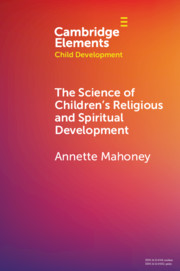Crossref Citations
This Element has been
cited by the following publications. This list is generated based on data provided by Crossref.
Crnic, Keith
and
Lin, Betty
2021.
Depression in Children's Lives.
Mahoney, Annette
2021.
The Science of Children's Religious and Spiritual Development.
Arterberry, Martha E.
2022.
Children's Eyewitness Testimony and Event Memory.
Massarwi, Adeem Ahmad
and
Gross-Manos, Daphna
2022.
The Association between Bullying Victimization and Subjective Well-Being among Children: Does the Role of Child Religiosity Matter?.
International Journal of Environmental Research and Public Health,
Vol. 19,
Issue. 15,
p.
9644.
Harris, Paul L.
2022.
Children's Imagination.
Winner, Ellen
and
Drake, Jennifer E.
2022.
The Child as Visual Artist.
Fivush, Robyn
2022.
Autobiographical Memory and Narrative in Childhood.
Gauvain, Mary
2022.
Cognitive Development in Infancy and Childhood.
Sanson, Ann V.
Malca, Karina Padilla
Hoorn, Judith Van
and
Burke, Susie
2022.
Children and Climate Change.
Sutton-Adams, Hannah
2023.
Recognizing Stones and Snakes in Children’s Christian Formation: An Introduction to Religious Trauma and Abuse.
Religious Education,
Vol. 118,
Issue. 4,
p.
356.
Gale, Megan
Hendricks, Justin J.
Dollahite, David C.
and
Marks, Loren D.
2023.
Perspectives on Lifespan Religious and Spiritual Development from Scholars across the Lifespan.
Religions,
Vol. 14,
Issue. 3,
p.
362.
Chen, Xinyin
2023.
Socialization and Socioemotional Development in Chinese Children.
Mahoney, Annette
Chinn, Jay R.
and
McGraw, James S.
2023.
Handbook of Positive Psychology, Religion, and Spirituality.
p.
445.
Minor, Cheryl
Sutton-Adams, Hannah
and
Ingersoll, Heather
2023.
Crossed Wires: The Disconnect Between Christian Leaders’ Perceptions of Parents and the Lived Experiences of Contemporary Families.
Religious Education,
Vol. 118,
Issue. 5,
p.
430.
Meek, Shantel
Catherine, Evandra
Boykin, Xigrid Soto-
and
Blevins, Darielle
2024.
Equity for Children in the United States.
NOVAK, Christoph
MATTES, Astrid
HASELBACHER, Miriam
and
LIMACHER, Katharina
2024.
Adapting my religion: How young believers negotiate religious belonging.
Social Compass,
Vol. 71,
Issue. 2,
p.
347.
Lo, Herman Hay Ming
2024.
Mindfulness for Children, Adolescents, and Families.
p.
15.
Sternberg, Robert J.
and
Desmet, Ophélie A.
2024.
Giftedness in Childhood.
Brodzinsky, David
and
Palacios, Jesus
2024.
The Adopted Child.
Bloch, Sebastian Boesgaard
Stripp, Tobias Anker
Nissen, Ricko Damberg
Wallin, Johan Albert
Hvidt, Niels Christian
and
Viftrup, Dorte Toudal
2025.
Measuring spiritual, religious, and existential constructs in children: A systematic review of instruments and measurement properties.
Archive for the Psychology of Religion,



